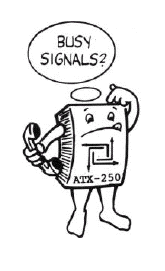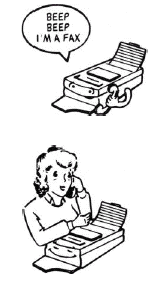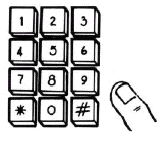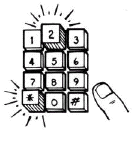Your ATX-250 will route incoming calls to the proper equipment and prevent other devices from interfering with the ongoing communication.
Your ATX-250 will only allow one DEVICE port to access the telephone line at a time. For example, if you are sending or receiving a FAX, your telephones and extensions will be unable to interrupt the communication. If you pick up your phone or FAX and hear a busy signal, then another device is already using the line.

Incoming calls can be routed to your communications equipment in several ways:
- Calls may be automatically transferred to your FAX machine if the caller is a FAX that produces a FAX identification tone.
- Calls may be manually transferred by dialing touch tones from either end of the line or with pulse-dialing telephone equipment attached directly to your Versa- Link ATX-250. Tones may be entered by the calling party any time after the first ring.
- Calls can be transferred to your MODEM if the caller is an auto-dial MODEM that dials the proper device selection code.
- All calls may be automatically transferred to DEVICE 2 after hours if CALL OPTI-MIZER is activated.

Most FAX machines have the capability to dial the receiving FAX number from memory. When the number is dialed, an identification tone is produced every 3-1/2 seconds that allows call processing equipment, like your ATX-250, to identify the call as originating from a FAX.
When auto FAX tone detection is turned on, your ATX-250 will transfer these calls to DEVICE 2, where your FAX machine is normally connected.
NOTE: Many FAX machines allow both voice and FAX calls to be dialed manually from their keyboard. Also, some older FAX machines do not have auto-dialing capability. These machines may not always produce the necessary identification tone for automatic transfer. Manual dialed FAX calls will ring through to your telephone system and are easily transferred to your FAX by dialing * 2
It is possible for female voices to produce sounds of the same pitch as the FAX identification (CNG) tone. To avoid inadvertant transfers, your ATX-250 only monitors the initial stage of incoming calls for CNG tones.
To transfer calls to a selected device, enter the proper device selection code on your telephone (or other equipment). The factory settings are:

Device Selection Codes
DEVICE 1 *3
DEVICE 2 *2
These device selection codes can be changed. See section 6.1 for detailed information on changing these codes.
The caller can manually transfer a call by using touch-tone
telephones or other equipment.
The called party can manually transfer a call with either touch-tone or pulse-dialing equipment connected through the ATX-250. If you plan to manually transfer calls with a pulse-dialing telephone, choose device selection codes that do not use the * symbol.

When to Enter A Device Selection Code
Device selection codes can be entered any time a call is in process. A caller can start entering device selection codes two seconds after hearing the first ring. This allows calls to be processed while the system is unattended.
Correcting Mistakes
If a mistake is made entering a device selection code, stop entering tones for two seconds or longer, and re-enter the correct device selection code. If you are dialing on a pulse-dialing phone, wait five seconds or longer before reentering the code.
Often it is desirable for all calls after hours and on weekends to go directly to the FAX machine or another automatic telephone device. This is especially useful when expanding a voice line with FAX and/or MODEM.
The primary application is for a company that has several incoming lines with rollover. Callers for voice traffic dial only one number. If that line is busy, the telephone company "rolls over" the call to a second incoming line. If the second line is busy, the call "rolls over", and so on until the incoming call finds a line that is not busy.
The last line is published as the FAX number. Any incoming FAX call will ring in on this line. During the day, the last line is primarily used for voice, but may also be used for both incoming and outgoing FAX. However, at night, any call coming in on the last line is assumed to be
a FAX. This is because all other lines would have to be busy for a voice call to come in on this line.
The CALL OPTIMIZER feature will count the number of times the telephone (attached to DEVICE 1) rings, after an incoming call has been screened for Auto-dial FAX tones and device codes. If the phone is not answered in 5 rings (this number is selectable - see section 6.2), your ATX-250 will assume that the office is unattended, and that this call and all future calls should go to the FAX. Your ATX-250 will immediately begin ringing this call to the FAX. (If your FAX has adjustable ring selection, set it to answer on the earliest possible ring). At this time, your ATX-250 begins to operate in NIGHT FUNCTION. Now, incoming calls will ring your telephone
system only 2 times (this number is selectable – see section 6.2), and then immediately ring the FAX. This will allow future incoming calls to go to the FAX sooner, with less chance of the caller hanging up before the FAX answers.
NIGHT FUNCTION is de-activated when you answer an incoming telephone call on this line within 2 rings or make an outgoing call on this line. Your ATX-250 will now operate in normal daytime function. This method of determining day/night/weekend is much simpler than using a clock or calendar which must continually be updated.
In the above example, a telephone system was connected to DEVICE 1, and a FAX to DEVICE 2. Of course, other devices may be substituted to fit your application.
IN SUMMARY, CALL OPTI-MIZER can be used when:
(a) You want all calls after hours to go to your FAX or
MODEM on DEVICE 2
(b) You DO NOT have an answering machine on the same
incoming line as your FAX or MODEM.
See section 6.2 to activate CALL OPTI-MIZER.
Your ATX-250 will answer incoming calls on the first ring and produce a simulated ringback tone to the caller. Your ATX waits about six seconds longer before it begins to ring DEVICE 1. During this time the caller may manually transfer the call by dialing a device selection code. Your ATX-250 is also screening the call for auto FAX tones.
If no auto FAX tone is detected, and if no device selection codes are entered, your ATX-250 will begin to ring the equipment attached to DEVICE 1. Once connected, your ATX-250 will isolate equipment attached to the other device ports for the duration of the call. Either party can manually transfer the call at any time. There is no limit to the number of times the same call can be transferred. During transfers, the caller is put on hold, and hears a ringback signal while the selected device is being rung. All devices that are not selected are disconnected from the telephone line. A busy signal is conveniently provided to all non-selected devices.
When the line is not in use, any device can place an outgoing call. During this time, all other devices are disconnected from the incoming line. If the caller is dialing long distance, charges begin when your ATX-250 answers incoming calls.
RINGING DEVICES
When your ATX-250 is ringing a device, it will attempt eight rings to that device. If the selected device does not answer within this period, your ATX-250 will disconnect the call and restore all devices to their original condition.
TRANSFER DEFEAT
Dialing "80" on an inbound call will cause your ATX-250 to ignore all device selection codes for the rest of that call. This is useful if you are calling into an answering machine to get your messages. This will prevent tones that may be on your incoming message tape from accidentally transferring your call.